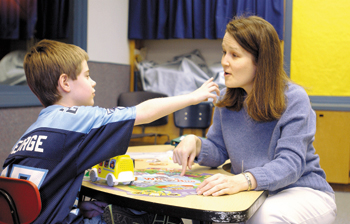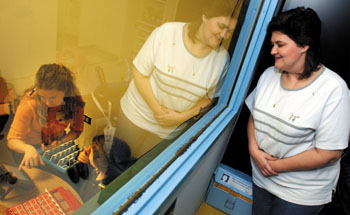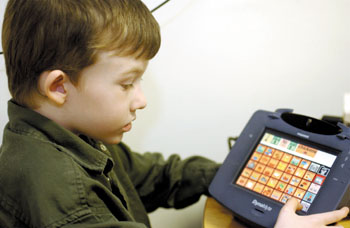
Filling the void — Specialized programs are opportunities unmatched

Ben Derryberry, 8, sees Jane Pramuk, a speech-language pathologist, for help communicating beyond the barriers of autism. Pramuk works at improving Ben’s verbal ability and getting past his tendency to insulate himself socially. (photo by Anne Rayner Pollo)

Denese Burnette drives from Franklin, Ky., three times a week to bring Tyler-Ray to therapy. Through a one-way window she watches speech pathologist Jenny Galbreth work with him. (photo by Dana Johnson)

Tyler-Ray Burnette, 5, uses a DynaMyte, a speech-generating device with a variety of words, phrases and sentences. (photo by Dana Johnson)
Each week Debbie Derryberry and Denese Burnette each travel 50 miles to the Vanderbilt Bill Wilkerson Center for Otolaryngology and Communication Sciences to spend hours alone sitting in dark observation rooms behind one-way windows, watching closely, listening intently to crackling speakers carry the sounds that the normal developmental process never visited upon their children—the ability to form distinct words or phrases to express themselves, their needs and wants, their joys and frustrations.
From their mere presence you understand that they would do anything for their children. They’ve had to do more than most.
Derryberry has made the commute from the family home in Columbia almost every Wednesday since her son Ben, 8, was diagnosed with autism in 1996. “He’s beginning to develop a little personality,” Derryberry says, eyeing Ben proudly through the glass as speech-language pathologist Jane Pramuk redirects his distracted looks to focus on talking with her.
Derryberry has had to watch milestones of her son’s development play out on the other side of the window. “He was like a blank personality, like living with someone and you’re just not connecting,” she says. Ben first acknowledged his grandparents when he was 3, she says, touching them and looking into their eyes for the first time.
Burnette’s 5-year-old son Tyler-Ray has Opitz syndrome, a genetic disorder that came with a load of complications, from lack of muscle control in his legs to a cleft palate that made speaking impossible. Three days a week they drive from their home in Franklin, Ky.
“They told us he’d never talk or walk,” Burnette says, watching Tyler-Ray step, albeit gingerly, around a table and talk, sometimes unclearly, to his speech-language pathologist, Jenny Galbreth. Vanderbilt surgeons first operated on Tyler-Ray when he was 4 weeks old. His latest operation, his eighteenth, patched his cleft palate. Afterward, he could make sounds, but couldn’t form them into words. In addition to physical and occupational therapies, speech-language pathologist Kathleen Herbert works with him to improve articulation, and then Galbreth, an augmentative communication specialist, teaches him how to use a speech generating device, something akin to a computer but limited to the speech production, to help him speak.
Specializing in special needs
The blanket of “communication sciences” covers the research and therapy programs that help people hear or, like Ben and Tyler-Ray, speak and otherwise communicate more appropriately or more clearly. But the Bill Wilkerson Center, as it was called until its merger in 1997 with Vanderbilt, built its reputation on covering more than the basics.
“Everyone knows we’re a hearing and speech center. But not a lot of people know about our specialized services,” says Mary Schaffer, speech-language pathologist, assistant professor of Hearing and Speech Sciences and director of the division of Speech Language Services.
Autism and augmentative communication are just two of the specialized programs. Others focus on feeding and swallowing disorders, hearing disorders (congenital and acquired), fluency (stuttering), language learning disorders for preschool and school-age children (the Center contracts with 30 school systems to provide services), and occupational therapy to augment speech-language pathology. The benefits of having these specialties are numerous: the Center attracts a higher level of graduate students in speech pathology and audiology to the training program and exposes medical students and residents to the possibility of specific successful therapies; Vanderbilt and Bill Wilkerson, now in one family, are distinguished as a center of excellence—possibly the only one of its kind in the nation, according to Fred Bess, Ph.D., chairman of the department of Hearing and Speech Sciences and associate director of the Center; and clinicians are on the cutting edge of research and practice techniques.
But most importantly, Schaffer says, it preserves possibilities for patients.
“The overall mission division is to serve children with communication disorders, with an emphasis on underserved populations—children with autism, feeding and augmentative communication needs. These are very unique services provided by staff who are specially trained in these areas. Families would not have these opportunities without us,” she says.
Another facet is community outreach. Many school systems contract with the Center for services, and several clinicians attend weekly meetings to advocate for children in the program. Families also drive to Nashville, many from out of state, for evaluations and treatment. Annually, around 650 children are continuously enrolled, 1,500 children receive new evaluations and another 2,000 from the Nashville area are screened.
Lisa Wallace directs the program’s autism team. It started in 1992 with four children and one clinician. Now six speech-language pathologists see 85 children each week. Most centers, Wallace says, see three to four.
Two full-time therapists specialize in augmentative devices—as technological as Tyler-Ray’s computer or as basic as simple symbols or sign language—and carry a caseload of 40 to 50 kids at any given time, says the augmentative communication team’s leader, Denise Bryant. “People just know to call here,” she says.
So do manufacturers. The large volume of children seen at Vanderbilt for the highly specialized needs of augmentative devices attracts companies testing their latest technological developments. The net gain for patients: more options unavailable to many centers.
“Some parents are in tears when they see what’s available to open up the lines of communication that didn’t exist before,” Bryant says. “We see kids using the devices who are able to express themselves finally, and that’s very rewarding for kids and their families and school systems. The whole world was acting on them, instead of them interacting with the world, then all of a sudden they’re able to communicate. It gives them so much power.”
Some of the equipment runs as much as $10,000. One family recently visited the center from Chicago, just to get a second opinion, before making a hefty purchase. “People just know to come here,” Bryant says.
The new building for the Vanderbilt Bill Wilkerson Center for Otolaryngology and Communication Sciences, being constructed on 21st Avenue adjacent to Medical Center East, will include a new lab especially for the devices, allowing more room for parents and children to test drive the products to find the right ones for them. And, with additional space in the building, the list of children waiting to be seen—now at around 200 names—will shrink, letting more children in.
Learning to share his world
“Some mothers might tell you they’re just as happy that their child has autism, but not me,” Debbie Derryberry says, sitting in the darkened room. She’s not a woman to sugarcoat anything. But there’s an irrepressible glow about her face when she talks about her son, even the difficulties they’ve experienced. “It’s hard. I love Ben to death, but do I wish he was a normal child? Of course I do.”
She recalls the day Ben was diagnosed with autism. “It was March 11, 1996. He was 2 years and 9 months old,” she says. She and her husband, Mark Derryberry, knew Ben wasn’t developing properly, not like their first child, Amy, had three years earlier. A pediatrician in Columbia told them not to worry about it. They thought he couldn’t hear. “He would act like we were invisible,” Debbie says. They saw an audiologist, who referred them to the Child Development Center, who referred them to Wendy Stone, Ph.D., professor of Pediatrics, a specialist in evaluation and diagnosis of children with autism spectrum disorders, a gamut of disorders that includes Ben’s autism diagnosis.
Five months after that audiology appointment, the family was at Vanderbilt seeing Stone. Diagnostic examinations and interviews took two days. When Stone and a team of clinicians finally told the Derryberrys what they suspected, the realization was harsh. “We were devastated,” Debbie says. “I can’t think of any other word.”
But the Derryberrys were resilient and resolved, and their love was undiminished. The next day, Debbie enrolled Ben in an “early lifestyle” program to help build socialization, and soon he was coming to the Bill Wilkerson Center.
The program, she says, “offers such individualized care. They’re sincere about it. Ben is Ben, he’s not just another patient.”
Ben functions at the mid-range of autism, Wallace says. He can read and write, but the primary deficit children with autism face is the use of pragmatic language, Wallace says. “They don’t know how to use the words, if they have them. If they’re non-verbal, we teach them to use symbols to communicate, instead of pulling everything out of the cupboards to get what they want.” The idea, Wallace says, is not to polish their “R” and “L” sounds, but to give them some means to get by in the world.
Ben pinched and threw tantrums early on, Debbie says. When he had a tool to use, a symbol, and later pictures and then words, his behavior improved.
But in addition to being non-verbal, autism stifles social interaction. While normally developing children will look at an object, then look at their parents to see if they have seen the object, a sharing experience, children with autism remain, literally, in their own world, keeping their discoveries to themselves.
The same is true with language. In therapy, Pramuk encourages Ben to talk, and to make eye contact with her, to share language and all its components.
Speaking beyond the syndrome
Denese Burnette knew all along her son would not develop normally. So did his father, she says. He told her he couldn’t live with a son that wasn’t normal, and he left. But now, five years later, she doesn’t begrudge him. She knows how difficult it can be.
Opitz was first described in 1965 by Dr. John Opitz, currently a professor of reproductive genetics at the University of Utah. The disorder is created by mutations on at least two chromosomes, “No. 22” and “X.” Characteristics include a list of words intimidating to parents: hypertelorism (wide-spaced eyes), hypotonia (weak muscle tone), laryngotracheal esophageal cleft (cleft palate). Many children don’t develop normally, some have mental disabilities, some die.
Tyler-Ray’s cleft palate and weak muscle tone made swallowing and talking almost impossible. “He would scoot across the floor to want he wanted and grunt or gesture,” Denese says. But Tyler-Ray is the epitome of perseverance. “He’s always been very strong-willed, very determined,” his mom says.
Surgery created a false palate, and his muscle tone improved. And, Denese says, “Intellectually, he’s extremely blessed. The good lord replaces what he takes.” And augmentative communication provided an alternative.
Some children, those with severe cerebral palsy, for instance, need permanent assistance with message boards that communicate with symbols or pictures, relaying messages from “I want to eat” to the “I want Cheerios.” Others, like Tyler-Ray, use a device as a bridge to cross from non-verbal into verbal.
Tyler-Ray uses a DynaMyte computer, a hand-held device the size of a lunch box that has about 15 pages of information with about 20 different keys per page. When he can’t clearly say what he wants to, he presses a key and the device “talks” for him by delivering one word at a time, phrases or sentences—one says his name and birthdate, another his address, another lists his friends.
The goal is not dependence. “It’s a tool for him to use when his communication breaks down,” Galbreth says. And it also teaches him proper sentence structure and vocabulary. Tyler-Ray repeats the DynaMyte’s message, a habit he’s developed himself, so correct speech is reinforced.
Like Ben, Tyler-Ray’s frustration at not being able to be understood diminished, and his behavior improved. He became more outgoing, more social. “He’s able to be Tyler-Ray,” Denese says. She credits Galbreth and the other therapists, their expertise and their commitment, with providing opportunities for Tyler-Ray.
“If he lives to be 50 years old, I’m not going to give up hope that he’s going to be carrying on a conversation with someone,” Burnette says.
Debbie Derryberry has similar aspirations for her son. “Vanderbilt has meant hope,” she says. “They’ve given me a lot of confidence that Ben will be a productive citizen someday.”
During his one-hour session with Pramuk, Ben occasionally glances toward the one-way window, never focusing for very long. When his therapy is over, he runs from the room, around the corner to where his mom has been watching. He pulls open the door, runs in and throws himself into her arms. Already, he’s had a productive day.













